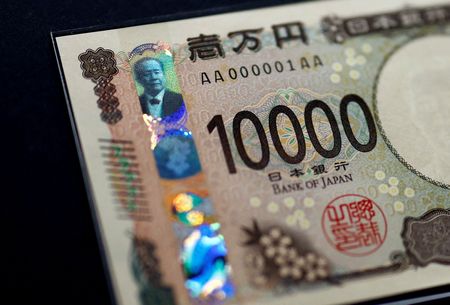By Alun John, Chibuike Oguh
NEW YORK/LONDON (Reuters) -The U.S. dollar fell against its major peers on Thursday, hitting a 10-year low against the safe-haven Swiss franc, as markets digested President Donald Trump’s dramatic reversal on tariffs.
Trump stunned financial markets on Wednesday by walking back steep duties on trading partners that had gone into effect less than 24 hours earlier. Trump granted a 90-day freeze on so-called “Liberation Day” tariffs but maintained a 10% blanket duty on most countries.
Tariffs on Chinese imports, however, were raised to 125% with immediate effect after China retaliated against previous U.S. duties with an 84% tariff rate. Total U.S. duties on Chinese imports are now 145% in addition to the new tariffs, according to the White House.
The U.S. dollar rebounded against the safe-haven Swiss franc and Japanese yen on Wednesday, while Wall Street’s main stock indexes leaped as the tariff reprieve brought some relief to investors.
But traders were readjusting their positions on Thursday, with the dollar dropping 2% to 144.795 yen and 3.6% versus the Swiss franc to 0.82635. The benchmark S&P 500, Dow and Nasdaq share indexes fell sharply.
The dollar has fallen 3.46% against the yen and nearly 6.5% against the Swiss franc so far this month. It is on track for the biggest one-day loss against the franc since January 2015.
“Up until yesterday’s 90-day reprieve, there was a pretty large dislocation in the market, across all markets in fact, and full adjusting to the tariff regime. But now that there’s a pause, every adjustment is basically being re-readjusted,” said Eugene Epstein, head of structuring for North America at Moneycorp in New Jersey.
Labor Department data on Thursday showed that U.S. consumer prices unexpectedly fell in March although the improvement in inflation is unlikely to be sustained in the wake of tariffs.
A drop in U.S. Treasury yields after a solid 10-year note auction was also partly weighing on the greenback. The yield on benchmark U.S. 10-year notes fell 2 basis points to 4.376%.
European Commission chief Ursula von der Leyen said on Thursday the EU will pause its first countermeasures against U.S. tariffs after Trump’s pause.
The euro was up nearly 2.47% at $1.1221 after hitting its highest since July 2023 and making its biggest one-day jump since 2022. The pound was up 1.13% at $1.29720.
Risk sensitive currencies were also firmer. The Australian dollar strengthened 1.24% to $0.62280, while the Swedish crown rose 1.5% versus the dollar to 9.839 crowns.
China’s central bank cut guidance for the official yuan rate for a sixth successive trading session on Thursday, signaling an intention to allow a very gradual depreciation.
Investors are waiting to see whether Chinese authorities use currency depreciation as part of the trade war.
The dollar weakened 0.49% to 7.307 yuan versus the offshore Chinese yuan but remained above Tuesday’s record low of 7.4288 yuan.
“Seeing the world as a zero-sum game is not very helpful. I don’t see this as a zero sum but that’s what the (Trump) administration is pushing,” said Marc Chandler, chief market strategist at Bannockburn Global Forex LLC. “The market requires a higher U.S. interest rate premium to stay long dollar.”
(Reporting by Chibuike Oguh in New York, Kevin Buckland in Tokyo and Alun John in London; additional reporting by Hannah Lang in New York; Editing by Ed Osmond, Kirsten Donovan, Will Dunham and Nia Williams)










